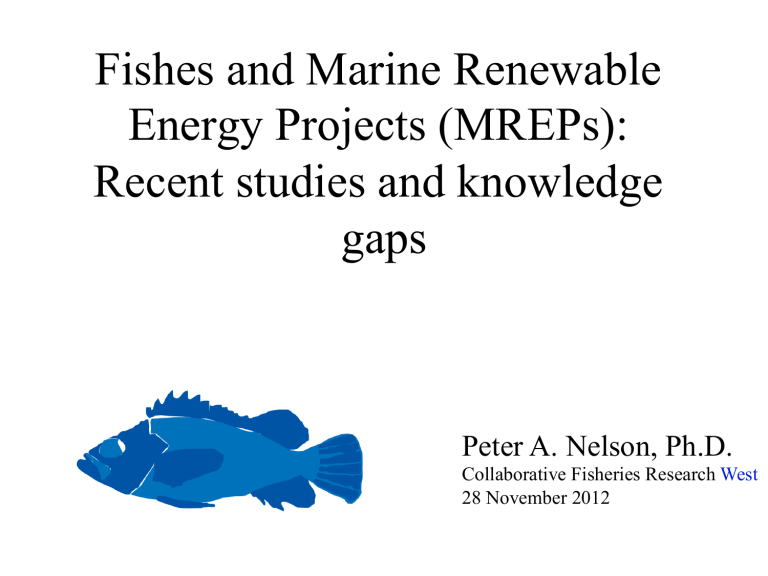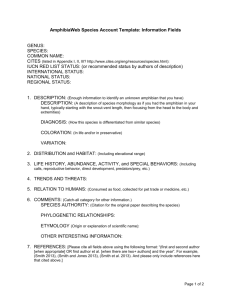Fishes and Marine Renewable Energy Projects (MREPs): Recent studies and knowledge gaps

Fishes and Marine Renewable
Energy Projects (MREPs):
Recent studies and knowledge gaps
Peter A. Nelson, Ph.D.
Collaborative Fisheries Research West
28 November 2012
sensory
• noise & vibration
• light & shadow
• chemical
• EMF
MREP effects
BEHAVIOR
ECOLOGY habitat
• artificial reefs
• FADs
• habitat loss
• habitat alteration
DISTRIBUTION
MORTALITY direct impact
• impingement
• strike
• entrapment indirect effects
• predators
• fishing access
MREPs and fishes design & technology species differences
• technology
• siting
• scale
Project design
60 m
50 m
sensory
• noise & vibration
• light & shadow
• chemical
• EMF
MREP effects technology
BEHAVIOR direct impact
• impingement
• strike
• entrapment habitat
• artificial reefs
• FADs
• habitat loss
• habitat alteration
DISTRIBUTION
MORTALITY indirect effects
• predators
• fishing access
Dover sole Petrale sole
100 fathom RCA
Observed CPUE Predicted Catch Probability Predicted CPUE
150 fathom RCA
Cowcod Conservation Areas low High High
Yelloweye Conservation Areas medium high
Trawl exclusion areas not detected
Low Low
Hardbottom Habitats
Draft Maps*, National Centers for Coastal Ocean Science
* Modified from the original. Thanks also to Environmental Defense Fund and The Nature Conservancy.
Green sturgeon
Locations of bottom trawl sets during
2000 and green sturgeon trawl bycatch, 1993-2000. from Erickson & Hightower 2007
UnderseaImages 2012
sensory
• noise & vibration
• light & shadow
• chemical
• EMF
MREP effects
IMPACTS? direct impact
• impingement
• strike
• entrapment habitat
• artificial reefs
• FADs
• habitat loss
• habitat alteration
DISTRIBUTION
MORTALITY indirect effects
• predators
• fishing access
Figure 4 from Gill et al. 2009
COWRIE 2.0, Phase 2
Spatial distribution of Raja clavata in mesocosm, KPDF analysis
Do MREPs act as FADs?
Fish Aggregating Devices
(FADs)
• flotsam, jetsam &
FADs
• how FADs are used
• drifting vs anchored
more FADs
• how & why fish associate with floating objects
• species differences
• is the FAD effect a tropical phenomenon?
conclusions
• couple baseline studies with the design of monitoring programs
• include a citizen science component
• study existing offshore analogues
• experimental research, basic and applied
• differences in technology may not be important, but project scale and species are
Acknowledgements
Sharon Kramer, Charlie Menza, Donna Schroeder, Laura Engeman and the many fishermen who’ve provided muscle, skill and insight. Also, HT
Harvey, BOEM, OWET, NOAA, ODFW, CDFG and USFWS.





